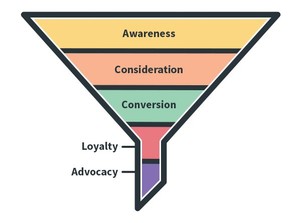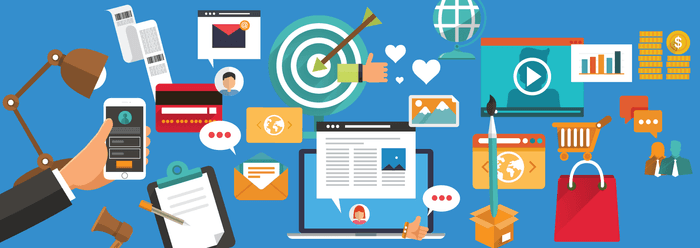Content
Why Automation is the Marketing Buzzword of 2018

Marketo claim that Sales agents spend 22% more time selling when marketing automation is deployed.
Chief Marketer claim that 28% of marketers saw an increase in revenue per sale attributable to marketing automation.
According to The Aberdeen Group, marketing automation-generated personalized emails improve click-through rates by 14% and conversion rates over 10%.
What is Automation?
If you’ve heard the word ‘automation’ thrown around recently as if it’s the holy grail of marketing, but are unsure if you actually need it, or how you could implement it, you’ve come to the right place.
Automation simply refers to technology specifically designed to automate your marketing strategies, such as email marketing campaigns, social shares and any other marketing channels that you or your company use as part of your process.
The ultimate goal of marketing automation is to streamline and optimise lead generation and lead nurturing, as well as more effectively measuring the success of these actions.
Marketing automation focuses on moving sales prospects from the top of the marketing funnel to the point of sales-ready leads at the bottom of the funnel by automating different marketing channels.
For example, here are a few ways marketing channels can be optimised that match different stages of the funnel:
- Awareness – automating tweets and Facebook and Linkedin posts gets your brand out in front of new people, increasing awareness.
- Consideration – If you shared a blog post on social, it will lead readers through to your website.
- Conversion – the more people on your site, the likelier it is you will get new subscribers to your mailing list.
- Loyalty– automate welcome emails for new subscribers, plus bi-weekly case studies and potential offers, and increase your lead generation!
- Advocacy – Send exclusive offers to existing customers, to keep them recommending you to others.
What are the Benefits/Disadvantages of Automation?
Advantages:
-
Saving Time – undoubtedly, one of the most tempting advantages of marketing automation is that all the repetitive, menial tasks are in the hands of an online tool, rather than eating into your working hours (or even non-working hours).
-
Personalisation – marketing automation allows you to gather data about your lead’s interests likes and dislikes, allowing you to customise future offers or content to be more relevant to them.
-
Solution for limited resources – particularly for small and medium-sized businesses, automation can substitute a big marketing team or new hires. It essentially builds efficiency into the process in all the right places.
Disadvantages:
-
Spam – this is the major worry with automation, in that if it’s used lazily it can end up with blasting irrelevant content to uninterested people. However, as long as you don’t cut corners and hone the strategy and content of what you’re sending out, you should end up with more tailored user experiences rather than more generic ones.
-
Tool cost – many tools used for automation come with subscription costs. Mailchimp for example is free for new businesses, but for growing businesses it offers unlimited email sending for a very reasonable $10 per month.
-
Strategy and planning – it’s essential to not cut corners with automation, therefore it requires a lot of trialing, A/B testing and careful planning in advance and during the process. It takes time, but will save time in the end.
How Can Automation be Used as Part of a Marketing Strategy?
Automation can be used at virtually every stage of the marketing process. Here are some ideas to get you started:
Sites like IFTTT allow you to connect many automated features to your Twitter for marketing purposes, including automatically welcoming and thanking new followers, sharing any WordPress blog posts automatically on your twitter feed, and scheduling tweets via your Google calendar.
Mailing Lists
At Kaizen, we use Mailchimp to create and save email templates, which we then use to send out carefully curated blog post round-ups, case studies of our campaigns and event sign-ups for the seminars and talks that we host. One of the best features is that when scheduling your campaign, you can let Mailchimp select the time for maximum engagement, and it will generate the best time for that day. To stay updated on Kaizen’s activities, and for the first tickets to our next event, sign up here.
Social Scheduling
You can use a tool called Hootsuite (for FREE) to manage all your social channels on one platform, including tracking and scheduling. You can also shrink links through the posting tool, which is great for staying with the twitter character link. For the more advanced among you, look into introducing UTMs as part of your strategy, which you can do on Hootsuite, and will allow you to track the links you post in terms of conversions.
What are Some Good Automation Tools?
Email Scheduling
Social Scheduling
Are There Any Case Studies to Support Automation as an Effective Marketing Process?
Still unconvinced that marketing automation is for you?
In 2016, the invite and stationery specialist PaperStyle.com published the results of their use of marketing automation in the form of personalised emails and follow-ups as part of a case study.
Their results:
- 244% higher open rate than average.
- 330% increase in revenue per mailing
- Click rate: 161% increase
From these results, we recommend A/B testing marketing automation as part of your marketing strategy, and seeing what results you can claim for your company!
For more blog posts like these, sign up to our bi-weekly newsletter on our website.
Casey Paul, 06/02/2018
Share










